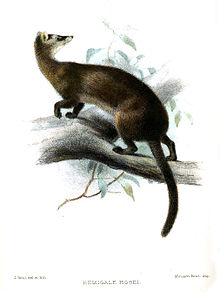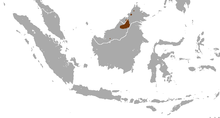| Hose's palm civet | |
|---|---|

| |
| Scientific classification | |
| Domain: | Eukaryota |
| Kingdom: | Animalia |
| Phylum: | Chordata |
| Class: | Mammalia |
| Order: | Carnivora |
| Suborder: | Feliformia |
| Family: | Viverridae |
| Subfamily: | Hemigalinae |
| Genus: | Diplogale Thomas, 1912 |
| Species: | D. hosei
|
| Binomial name | |
| Diplogale hosei | |

| |
| Hose's palm civet range | |
Hose's palm civet (Diplogale hosei), also known as Hose's civet, is a viverrid species endemic to the island of Borneo. It is listed on the IUCN Red List as Vulnerable because of an ongoing population decline, estimated to be more than 30% over the last three generations (inferred to be 15 years) and suspected to be more than 30% in the next three generations due to declines in population inferred from habitat destruction and degradation.[1]
Diplogale is a monospecific genus.[3] Hose's palm civet was named after the zoologist Charles Hose by Oldfield Thomas in 1892. Hose collected the first specimen in Sarawak in 1891.[2]
What little is known of the species comes primarily from 17 museum specimens worldwide. Only in 1997, the first living specimen was obtained and released after two months. Hose's civet is not kept in captivity anywhere in the world.[4]
- ^ a b Mathai, J.; Duckworth, J.W.; Wilting, A.; Hearn, A.; Brodie, J. (2015). "Diplogale hosei". IUCN Red List of Threatened Species. 2015: e.T6635A45197564. doi:10.2305/IUCN.UK.2015-4.RLTS.T6635A45197564.en. Retrieved 19 November 2021.
- ^ a b Thomas, O. (1892). "On some Mammals form Mount Dulit, North Borneo". Proceedings of the Zoological Society of London. Part I: 221–226.
- ^ Wozencraft, W. C. (2005). "Genus Diplogale". In Wilson, D. E.; Reeder, D. M. (eds.). Mammal Species of the World: A Taxonomic and Geographic Reference (3rd ed.). Johns Hopkins University Press. p. 552. ISBN 978-0-8018-8221-0. OCLC 62265494.
- ^ Yasuma, S. (2004). "Observations of a live Hose's Civet Diplogale hosei" (PDF). Small Carnivore Conservation. 31: 3–5. Archived from the original (PDF) on 2012-04-26.
